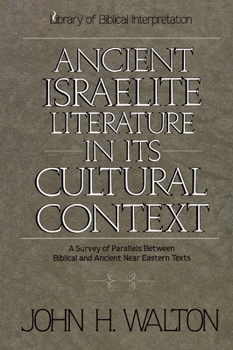Ancient Israelite Literature in Its Cultural Context: A Survey of Parallels Between Biblical and Ancient Near Eastern Texts
Select Format
Select Condition 
Book Overview
This unique book surveys within the various literary genres the parallels between the Bible and the literature of the ancient Near East. Each section begins with a survey of the available ancient literature, continues with a discussion of the literature, and concludes with a discussion of cases of alleged borrowing. The genres covered are - cosmology - laws - historical literature - wisdom literature - apocalyptic literature - personal archives...
Format:Paperback
Language:English
ISBN:0310365910
ISBN13:9780310365914
Release Date:August 1994
Publisher:Zondervan Academic
Length:256 Pages
Weight:0.70 lbs.
Dimensions:1.0" x 6.0" x 8.9"
Related Subjects
Ancient & Classical Literature Bible Study & Reference Christian Books & Bibles Criticism & Interpretation Criticism & Theory Greek Hebrew Bible (Old Testament) History & Criticism Literature & Fiction Old Testament Reference Religion Religion & Spirituality Sacred Writings World LiteratureCustomer Reviews
3 ratings
Helpful companion to OT background study
Published by Thriftbooks.com User , 19 years ago
Dr. Walton's work is well worth reading. As one reviewer suggests, background material is very helpful in shedding light on the text and meaning of the Old Testament. To be fair to Walton, however, requires a more thorough explanation. Walton's general thesis is that the comparative method can help readers understand the Old Testament better because it helps put us in the place of the original author/audience. While there was an effort earlier in the 19th and 20th centuries to point out only the similarities between texts or only the differences, Walton's approach is similar to that of William Hallo or Lawson Younger; namely, to think through both the similarities and the differences between ancient near eastern texts and the OT biblical canon. What is particularly helpful about Walton's book is that the material is arranged according to genre. The following genres are covered: cosmology (trying to understand the ancient's conceptual worldview) law codes historical literature wisdom literature apocalyptic literature personal archives covenants and treaties hymns, prayers and incantations prophetic literature By grouping various ancient texts in this fashion, it provides the reader with a well organized approach and makes using this book as a quick reference very helpful. Each chapter contains an introductory piece on the literary genre, followed by a brief but thorough listing of ancient texts that fit into this genre from Egypt, Canaan and Mesopotamia (absolutely replete with bibliography), concluded by a discussion of the texts and what kinds of insights can be given into biblical texts. It is a trustworthy evaluation because Walton is a faithful evangelical as well as a rigorous scholar. It is important to note that he points out both the similarities and differences. In recognizing similarities, he doesn't suggest gross borrowing, as some in the past suggested, but rather that the biblical material is given by revelation from God into a cultural context that could appropriately understand and receive God's revelation. In this way he upholds the authority of Scripture. Furthermore, he demonstrates very significant differences between the ancient near eastern literature and the biblical corpus such that it becomes increasing clear that the OT functions in different ways we normally wouldn't recognize: polemically against ancient cultures; demonstrating the LORD to be unique and holy compared to other deities; and revealing how extraordinary it is that the LORD, his character, ways and will can be known by the Hebrew people. Another highlight is that the reader will learn a bit about the comparative method as well. Walton always takes into consideration the following important factors: Are the texts to be compared of the same genre? Are the texts to be compared talking about the same subject matter? Are the texts being compared geographically close enough to suggest an influence one way or another? Are the texts being compared c
Is There Any Other Way?
Published by Thriftbooks.com User , 20 years ago
The relationship between biblical history and a text that purports to transmit it has long been an interest of mine. Only Fundamentalists can not see that there is a difference between the order of creation found in Genesis 1 and 2. Long ago it occurred to me that the most appropriate way to analyze the historicity of the Bible is to compare it to other writings. Walton breaks down the literature of the Old Testament into categories such as cosmology, personal archives, legal texts, etc. Each chapter considers the related material, discusses the possibility of borrowing, and suggests further reading. Most of all Walton discusses questions such as whether the Patriarchal Narratives could be personal archives. Though he is a Christian Evangelical, he is willing to concede that Thomas Thompson's _Historicity of the Patriarchal Narratives_ et al have made a significant case.The whole of this debate will go on for years more. This book is for those who want to begin wading through James Pritchard's _Ancient Near Eastern Texts_ or Hallo's and Younger's _Context of Scripture_ in order to compare Israelite literature with that of surrounding cultures. In the final analysis, is there any other way?
Critically and evangelical study of literary parallels
Published by Thriftbooks.com User , 27 years ago
The author thoroughly reviews ancient near eastern texts, and compares them to the texts and books of the Old Testament. He gives an analyses of all major genres of the Old Testament literature, and looks for meaningful parallels. This book is highly recommendables, because it is unique in viewing the Old Testament as God's revelation, but nevertheless being honest to the texts he compares them to.Simply a must for every student of theology and for every pastor who takes bible and the ancient world for serious





